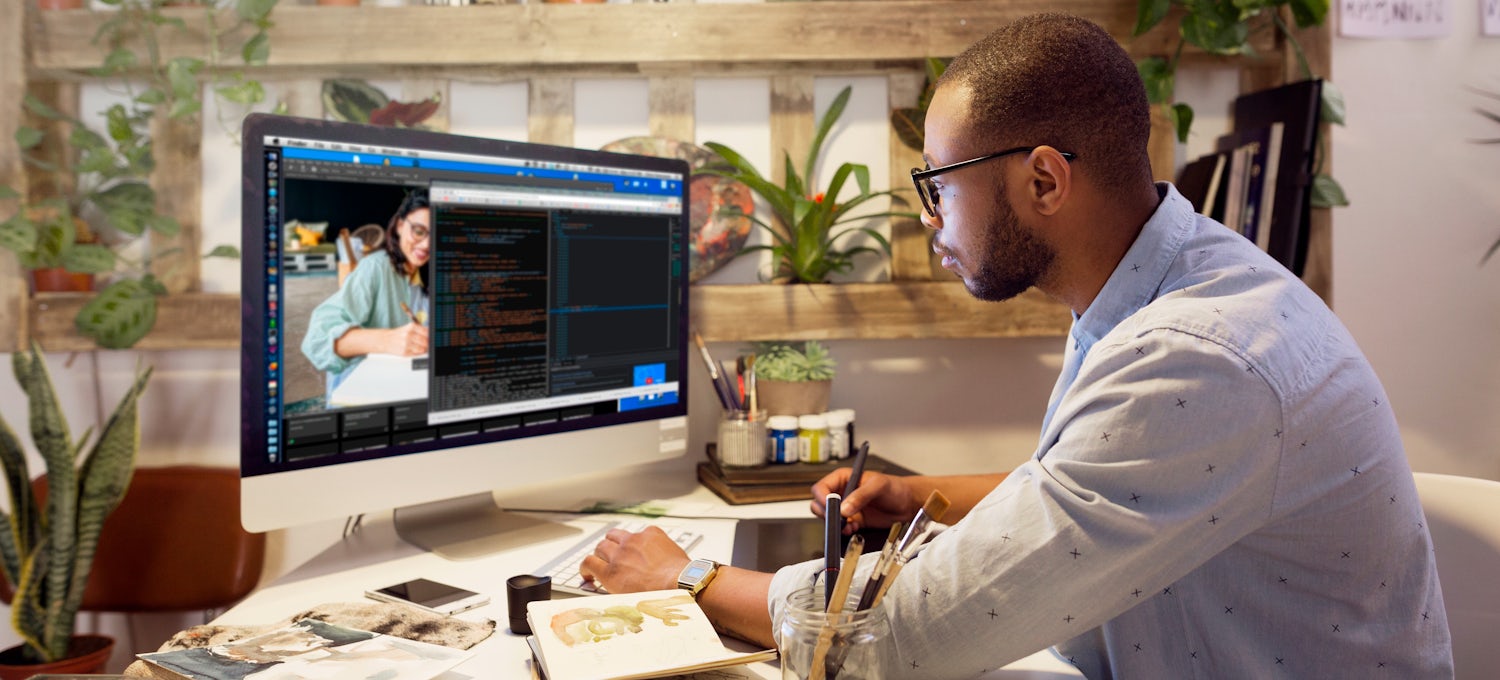Exactly How to Successfully Combine Visual Appeals and Performance in Web Design
When creating a web site, you require to strike a balance between looks and functionality. It's not just about looking great; your design needs to additionally offer a function and overview customers successfully. By concentrating on simplicity and instinctive navigating, you can produce an appealing experience. What aspects really boost usability while preserving aesthetic appeal? Let's check out the key concepts that can bring about a harmonious blend of appeal and feature.
Comprehending the Importance of Aesthetics and Functionality
When you create a website, comprehending the balance in between appearances and performance is vital for developing a reliable customer experience. A visually appealing site grabs interest, however it's the capability that maintains users involved. If your site looks excellent but is tough to browse, visitors will quickly weary and leave.Consider your target audience and what draws them in. You intend to create a layout that mirrors your brand while guaranteeing ease of use. Streamlined designs, instinctive navigating, and clear phone call to activity can boost both appearances and performance.

Principles of Reliable Website Design
To create an effective website design, you need to abide by numerous crucial concepts that boost both individual experience and aesthetic appeal. Prioritize simpleness; a tidy layout aids customers navigate quickly. Use a constant color pattern and typography to preserve coherence throughout your site. This promotes familiarity and trust.Next, assure your layout is receptive. Customers access internet sites on different tools, so your design needs to adapt perfectly. Focus on aesthetic power structure; emphasize important components with dimension, shade, or placement to guide users' focus.Finally, integrate adequate white area. It prevents clutter and makes material a lot more digestible. Bear in mind, effective website design equilibriums looks and functionality, so every layout choice should offer a purpose. By following these principles, you'll produce a website that's not only visually enticing but likewise straightforward, inevitably keeping visitors engaged and motivating them to return.
Focusing On Customer Experience
When prioritizing user experience, you'll intend to begin by recognizing what your customers genuinely require. Streamlining navigation style can make a significant difference in just how easily they locate what they're searching for. Improving visual pecking order assists assist their attention to the most essential aspects on your site.
Understanding User Demands
Recognizing customer requirements is necessary for creating an engaging internet experience that maintains visitors returning. To achieve this, you must determine the objectives and choices of your target market. Start by conducting individual research study, like interviews or surveys, to gather understandings on what users value most. Take note of their pain factors and challenges when interacting with similar sites. This info allows you to customize your style, ensuring functionality aligns with user expectations. Furthermore, consider creating individual personas that represent various segments of your target market, aiding you envision their demands throughout the layout process. When you focus on recognizing customer demands, you develop a site that not just looks great but likewise delivers a seamless, delightful experience that cultivates loyalty.
Streamlining Navigating Layout

Enhancing Visual Hierarchy
A strong aesthetic hierarchy is essential in directing customers through your site and guaranteeing they engage with key content. To accomplish this, make use of shade, dimension, and spacing purposefully. Make vital aspects like headings larger and bolder than body message, drawing interest promptly. Make use of contrasting colors to highlight phone call to activity, encouraging clicks. Additionally, use adequate white room to separate sections, making material digestible and inviting.Consider the circulation of details; set up components practically, leading users' eyes from one factor to the next. Use aesthetic hints, like lines or arrows, to guide focus. By prioritizing visual hierarchy, you boost user experience and boost the probability of conversions, guaranteeing your web site is both aesthetically pleasing and functionally effective.
Shade Concept and Its Influence on Usability
While picking the why not look here ideal shades for your internet site may look like a small information, it substantially affects functionality and user experience. Shade affects how users regard information and can prevent or boost navigation. For circumstances, contrasting colors can assist vital components stand apart, making it much easier for visitors to locate what they need.Additionally, consider the psychology of shades: blue often inspires trust fund, while red creates necessity. Understanding your target audience can guide your color choices, ensuring they reverberate well.Moreover, constant color design assist construct brand name identification, making your internet site extra remarkable. Be mindful-- as well lots of shades can overwhelm individuals. Stay with a minimal scheme that complements your material and preserves clarity.Incorporating access is additionally essential; validate your shade combinations are friendly for those with aesthetic problems. By attentively applying shade concept, you'll improve usability and produce a more interesting customer experience.
Typography: Harmonizing Design and Readability
Shade selections established the stage for your internet site, but typography plays a just as vital role in improving individual experience. You desire your message to connect plainly while also mirroring your brand name's individuality. Begin by picking font styles that are not just attractive however additionally understandable. Sans-serif typefaces often function well for electronic screens, as they're easier to read at various sizes.Maintain a power structure by utilizing different font dimensions and weights; this guides users via your material effortlessly. Take into consideration line spacing and letter spacing; also limited can annoy readers, while as well loosened can interrupt the flow. Limitation your font style selections to 2 or 3 to keep the design cohesive.Finally, constantly examine your typography across different devices and browsers. What looks excellent on one screen might not on an additional. Stabilizing design with readability warranties that your message reverberates, maintaining your target market educated and involved.
Responsive Style: Making Looks Work on All Instruments
To assure your site looks fantastic on any tool, you'll need to accept receptive layout concepts. This approach guarantees your site adapts to different display dimensions, providing an ideal customer experience. Beginning by using liquid grids and flexible images that scale flawlessly. Rather than fixed measurements, select portions and family member systems, enabling your design to change Our site dynamically.Next, apply media queries in your CSS. These allow you apply different designs based on device attributes, like screen size. In this manner, you can keep aesthetic charm while guaranteeing functionality.Don' t forget touch targets; ensure buttons and links are very easy to tap on smaller displays. Focus on essential web content, so individuals can quickly browse your site no matter their device. By concentrating on these components, you'll create an engaging, aesthetically appealing experience that satisfies the needs of all users, whether they get on a desktop, additional hints tablet, or smart device.
Conducting Functionality Testing for Continuous Enhancement
To enhance your website design, you need to establish clear usability objectives that straighten with individual requirements. By performing customer tests, you can collect beneficial responses on exactly how genuine people connect with your site. Evaluating these outcomes will aid you make notified renovations and develop a more effective individual experience.
Defining Functionality Goals
While appearances can attract individuals in, defining usability objectives is essential for guaranteeing their experience stays gratifying and smooth. Begin by identifying what you desire users to achieve on your site (website design london Ontario). Consider their demands, behaviors, and tasks. Are they searching for info, making a purchase, or authorizing up for a newsletter? Establish clear benchmarks to determine success, like task conclusion rates or time on job. Prioritize intuitive navigation, easily accessible web content, and receptive style to enhance use. On a regular basis review these goals as individual expectations evolve. By defining use objectives, you produce a structure for examining and enhancing your internet site's efficiency. This concentrate on usability not only improves customer complete satisfaction however additionally strengthens the overall performance of your design
Conducting User Tests
Carrying out customer tests is essential for refining your website and guaranteeing it fulfills your target market's requirements. Beginning by identifying your target customers and producing an examination plan that details your purposes. Use a mix of measurable and qualitative methods, such as surveys, interviews, and task-based observations, to gather comprehensive comments. Invite individuals to browse your website while you observe their communications and keep in mind any problems they come across. Encourage open discussion to capture their ideas and feelings regarding the style and performance. Maintain sessions brief and concentrated, guaranteeing you cover essential areas without frustrating individuals. Make certain to document all searchings for, as this information will certainly be very useful for making informed style choices that boost both aesthetics and usability.
Evaluating Test Outcomes
Just how can you effectively analyze the results of your functionality tests to drive constant improvement? Start by classifying feedback into common styles. Search for patterns in customer actions that highlight discomfort points or areas for improvement. Usage measurable information, like task completion prices and time on task, to determine usability objectively. Don't neglect to think about qualitative insights from user comments; they commonly expose underlying issues that numbers can't reveal. Prioritize one of the most impactful findings and create actionable items for your layout group. Bear in mind, it has to do with iterating-- carry out adjustments, after that examination again. This cycle of testing, assessing, and refining assists you equilibrium aesthetics and capability, ensuring your web site meets individual demands efficiently while keeping visual allure.
Often Asked Questions
Exactly how Do I Pick the Right Shade Scheme for My Web site?
To pick the right shade palette for your site, consider your brand name's individuality, target market, and emotional effect (website design london Ontario). Usage shade psychology, develop consistency, and assurance readability. Test mixes to see what resonates best with visitors
What Equipment Can Assist With Website Design Appearances and Performance?
You can use tools like Adobe XD, Figma, and Sketch to boost your website design's looks and capability. These platforms use user-friendly interfaces, partnership functions, and pre-made layouts to improve your imaginative process and boost your styles.
How Can I Integrate Animations Without Compromising Functionality?
To include computer animations without endangering performance, prioritize subtle effects that boost customer experience. Use CSS computer animations for smoother communications, guarantee quick load times, and test on different devices to keep efficiency while adding visual appeal.
What Are Typical Errors to Avoid in Website Design Aesthetics?
When making, stay clear of messy designs, poor color selections, and irregular fonts. Don't forget mobile responsiveness, as it can push away individuals. Verify your style straightens with your brand, creating a seamless experience that involves visitors efficiently.
How Typically Should I Update My Web site's Layout for Optimum Visual Appeals?
You need to upgrade your site's design every 1-2 years to stay on top of patterns and preserve optimal visual appeals. Regularly renewing visuals assists involve visitors and guarantees your website remains user-friendly and enticing. When you develop a web site, understanding the balance in between looks and performance is important for creating a reliable customer experience. To create an effective internet style, you require to adhere to numerous essential concepts that improve both user experience and aesthetic charm. Customers accessibility web sites on numerous devices, so your design needs to adapt flawlessly. When focusing on user experience, you'll want to start by comprehending what your individuals really require. Begin by conducting user study, like studies or meetings, to collect insights on what customers value most.